CNA Patient Ratio Laws by State

Certified nursing assistants, or CNAs, are important members of a direct care nursing team. They’re commonly employed in long-term care facilities, hospices, home health, and hospitals. As caregivers, CNAs are responsible for reducing the risk of patient harm. The care they provide prevents adverse events, such as pressure ulcers and falls, that cost the healthcare industry billions of dollars a year.
A balanced workload can reduce the risk of patient harm, while helping with retention, but in many states, there’s no limit to the number of patients a CNA cares for on a given shift. We’ve compiled the CNA patient ratio laws by state below. But first, some context about the work of a CNA and how care standards are quantified.
How Direct Care Nursing Teams Work
The most common workplaces for CNAs are post-acute care facilities, which include assisted living, skilled nursing facilities, and nursing homes. In these settings, nursing care is divided among disciplines. Licensed nursing professionals and aides provide hands-on care to residents. Direct care nursing staff consists of:
- Registered nurses (RNs)
- Licensed practical nurses (LPNs)
- Certified nursing assistants (CNAs)
A healthcare administrator, such as a director of nursing (DON), oversees staff and residents. Because they round on residents and families throughout the day, the DON may count in nurse staffing hours.
Per nursing home regulations, residents’ time with nursing staff is measured in staffing hours per resident per day (HPRD). This metric is used to measure how much nursing attention a resident gets in a 24-hour period. Some states have guidelines for HPRD, whereas others have mandated CNA-to-patient ratios.
Understanding CNA Patient Ratio Laws by State
If you’re looking to improve your facility’s patient safety standards and the positions you’ll need to fill, you may be wondering, what is the legal CNA-to-patient ratio in a hospital? The answer isn’t clear cut, as there’s wide variance in CNA patient ratio laws by state (and additional differences among the various types of facilities). For example, the CNA-to-patient ratio in North Carolina may be different than in Illinois, where facilities may face fines if they don’t meet staffing standards.
The federal government has been making ongoing efforts to establish national staffing minimums for long-term care facilities. However, these regulations are facing judicial review and have yet to be fully implemented.
This doesn’t let facilities off the hook, though. The Centers for Medicare and Medicaid Services (CMS) holds nursing homes accountable for their conditions with a public reporting and rating system. The Five Star Quality Rating System is designed to offer information to the public about nursing home staffing data, including:
- Nurse staffing hours per resident per day.
- Nurse turnover.
- Administrator turnover.
The report is released quarterly and is meant to encourage facilities to be transparent about staffing. Facilities must also submit an annual assessment that addresses residents’ needs and the facility’s ability to meet them. While CMS doesn’t currently enforce staffing ratios, it recommends facilities have “sufficient staff” to meet the needs of residents within a 24-hour period.
Public reporting is available on Medicare’s Care Compare site, which shows data about nurse staffing and time with residents.
Care Standards by State
States without staffing ratio mandates refer to CMS guidelines, which indicate that facilities must have “sufficient staff” to care for all residents. This language leaves it up to facilities to define what appropriate staffing means for their residents. This is why it’s so important to understand the nuances of CNA patient ratio laws by state. Here are some questions to ask when considering what sufficient staffing means at your facility:
- With these staffing ratios, will caregivers be able to uphold high-quality standards of care (such as skin breakdown prevention, fall prevention, etc.)?
- Could these staffing ratios put a nurse’s license at risk?
- Will residents’ families feel safe leaving a loved one in your facility?
- Would you send a loved one to your own facility?
Other states have mandates to determine staffing standards, such as:
- The number of direct care staff (RN, LPN, or CNA) per resident.
- CNA-to-patient ratios.
- Hours per resident per day (HPRD).
In certain states, such as Delaware and California, facilities may submit a waiver to bypass staffing minimums. Read about the CNA patient ratio laws by state below for more details.
| State | Direct Care Staff Ratios | Hours Per Resident Per Day (HPRD) |
|---|---|---|
| Alabama | Sufficient staff on a 24-hour basis | No minimum requirement |
| Alaska | Sufficient staff | No minimum requirement |
| Arizona | Sufficient staff | No minimum requirement |
| Arkansas | 1-16 residents: 1 direct care staff on days, evenings, and nights
17-32 residents: 2 direct care staff on days, 1 on evenings, 1 on nights 33-49 residents: 2 direct care staff at all times 50-66 residents: 3 direct care staff on days, 2 on evenings, 2 on nights 67-83 residents: 4 direct care staff on days, 2 on evenings, 2 on nights 84 or more residents: 5 direct care staff on days, 3 on evenings, 2 on nights |
3.36 average HPRD per month |
| California | Sufficient staff
16-100 residents: 1 awake staff 101-200 residents: 1 on call and 1 awake staff, with an additional awake staff for each additional 100 residents |
2.4 HPRD, CNAs |
| Colorado | No minimum ratios for nursing homes
Alternative care facilities must staff 1:10 on days, 1:16 at night |
2 HPRD, direct care |
| Connecticut | Rest homes: Must be at least 1 CNA on every residential floor | CNAs:Rest homes: 0.7 HPRD between 7am and 9pm; 0.17 HPRD between 9pm and 7am
Chronic and Convalescent Nursing Homes: 1.4 HPRD between 7am and 9pm; 0.5 HPRD between 9pm and 7am |
| Delaware | Direct care staff:
1:7 on days 1:10 on evening shift 1:15 on nights |
3.28 HPRD, CNA |
| Florida | CNAs:
1:20 |
2.5 HPRD, CNAs |
| Georgia | Direct care staff:
1:15 on days 1:25 at night |
2 HPRD, direct care |
| Hawaii | No minimum ratios | No minimum requirement |
| Idaho | Sufficient staff | 2.4 HPRD, direct care |
| Illinois | Sufficient staff | Intermediate care:
2.5 HPRD Skilled nursing care: 3.8 HPRD A minimum of 25% of care must be from an LPN, 10% from an RN |
| Indiana | Direct care staff:
1:50 |
No minimum requirement |
| Iowa | Assisted living: Sufficient staff
Residential care (direct care staff): 1:25 on days 1:35 on evening shift 1:45 on nights |
2 HPRD; 20% of care must be from an RN or LPN |
| Kansas | Direct care staff:
1:30 |
1.85 HPRD daily minimum
2 HPRD weekly average |
| Kentucky | Sufficient staff | No minimum requirement |
| Louisiana | Sufficient staff | 2.35 HPRD, direct care staff |
| Maine | Direct care staff:
1:5 on days 1:10 evening shift 1:15 night shift |
2.93 HPRD, CNA |
| Maryland | 1:15, nursing service personnel | 3 HPRD, CNA |
| Massachusetts | Sufficient staff | 3.58 HPRD, CNA (0.508 must be provided by RN) |
| Michigan | Direct care staff:
1:8 on days 1:12 evening shift 1:15 on nights |
2.25 HPRD |
| Minnesota | Minimum 2 direct care staff available at all times | 2 HPRD |
| Mississippi | Direct care staff:
1:15 on days 1:25 on nights |
2.8 HPRD, direct care staff |
| Missouri | Direct care staff:
1 personnel for every 3-10 residents on days, 1 personnel for every 3-15 residents on evenings, 1 personnel for 3-15 residents on nights; 1 additional personnel for every fraction thereafter |
No minimum requirement |
| Montana | Sufficient staff | No minimum requirement |
| Nebraska | Sufficient staff | No minimum requirement |
| Nevada | Sufficient staff | No minimum requirement |
| New Hampshire | Sufficient staff | No minimum requirement |
| New Jersey | CNAs:
1:8 on days 1:10 on evenings 1:16 on nights |
2.5 HPRD |
| New Mexico | Skilled nursing facilities (direct care staff): 1:7 on days 1:10 on evenings 1:12 on nights Intermediate care facilities (direct care staff): 1:8 on days 1:10 on evenings 1:13 on nights |
Skilled nursing facilities: 2.5 HPRD, direct care staff
Intermediate care facilities: 2.3 HPRD, direct care staff |
| New York | Sufficient staff | 3.5 HPRD (at least 2.2 with a CNA, no less than 1.1 with an RN or LPN) |
| North Carolina | CNAs:
1:20 on day and evening shift 1:30 on nights 1 CNA per floor of multistory facilities |
No minimum requirement |
| North Dakota | Sufficient staff | No minimum requirement |
| Ohio | Sufficient staff | 2.5 HPRD, STNA |
| Oklahoma | Direct care staff: 1:6 on days 1:8 evening shift 1:15 on nights |
3.81 HPRD direct care (2.6 of which are from a CNA) |
| Oregon | CNAs:
1:7 on days 1:9.5 on evening shift 1:17 on nights |
2.46, CNA |
| Pennsylvania | CNAs:
1:10 on days 1:11 on evening shift 1:15 on nights |
3.2 HPRD direct care |
| Rhode Island | Sufficient staff | 2.6 HPRD, CNA
3.81 HPRD, total direct care |
| South Carolina | Direct care staff:
1:9 on days 1:13 evening shift 1:22 on nights |
1.63, HPRD, CNA |
| South Dakota | Sufficient staff | No minimum requirement |
| Tennessee | Sufficient staff | 2 HPRD (0.4 hours should be from a licensed nurse per shift) |
| Texas | Direct care staff:
1:8 at all times |
No minimum requirement |
| Utah | Sufficient staff | No minimum requirement |
| Vermont | Sufficient staff | 3 HPRD (includes at least 2 HPRD provided by CNA weekly average) |
| Virginia | Sufficient staff | No minimum requirement |
| Washington | Sufficient staff | 3.4 HPRD, CNA |
| Washington D.C. | Sufficient staff | 4.1 HPRD, CNA (0.6 hours by an RN) |
| West Virginia | Sufficient staff | 2.25 HPRD, CNA |
| Wisconsin | Sufficient staff | 3.25 HPRD (including 0.65 LN HPRD) for intensive skilled nursing care, 2.5 HPRD (including 0.5 LN HPRD) for skilled nursing care, 2 HPRD (including 0.4 LN HPRD) for intermediate or limited nursing care |
| Wyoming | Sufficient staff | 2.25 HPRD for skilled residents, 1.5 HPRD for non-skilled residents |
*Data was collected from the National Consumer Voice for Quality Long-term Care, the Department of Health and Human Services, and individual state government pages.
Get CNAs Into Your Facility Fast
Now that you know the CNA patient ratio laws by state, are you concerned about whether your facility is in compliance? Our dynamic, scalable staffing solutions can help you get the quality nursing professionals you need, when you need them.
IntelyCare writer Katherine Zheng, PhD, BSN, contributed to the research and writing of this article.



